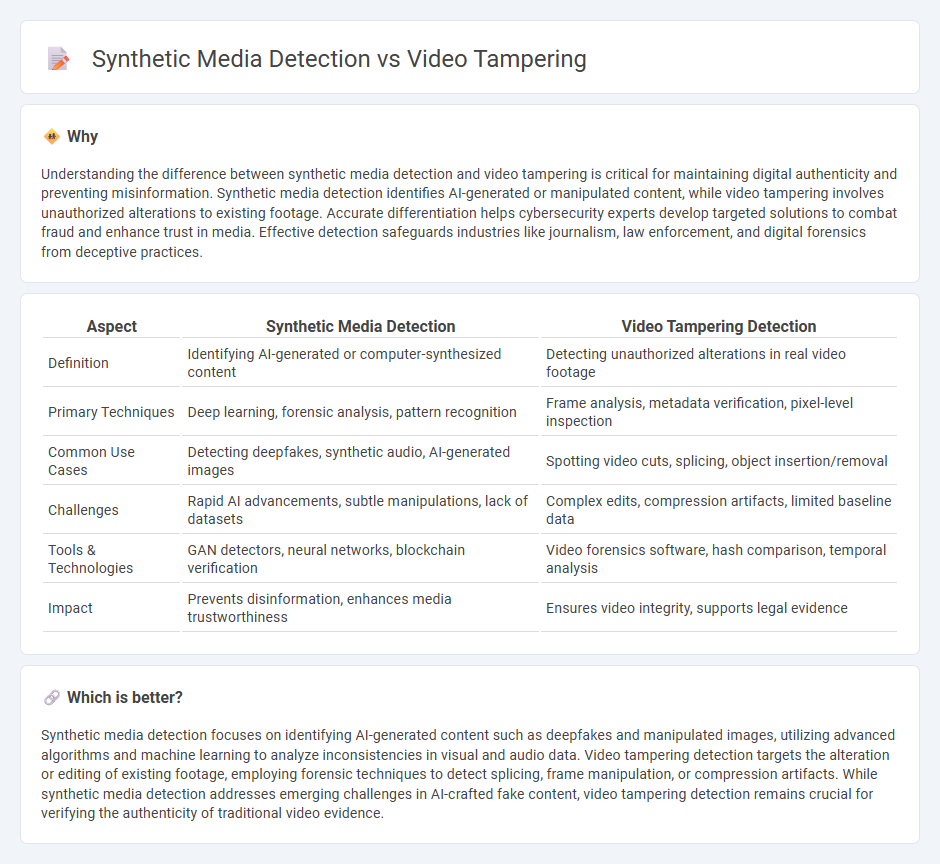
Synthetic media detection focuses on identifying AI-generated or manipulated content, such as deepfakes, by analyzing inconsistencies in audio-visual signals and metadata. Video tampering involves unauthorized editing or alteration of video footage to misrepresent events, often using techniques like frame duplication or splicing. Explore how advanced algorithms and forensic tools are evolving to combat these challenges in digital content integrity.
Why it is important
Understanding the difference between synthetic media detection and video tampering is critical for maintaining digital authenticity and preventing misinformation. Synthetic media detection identifies AI-generated or manipulated content, while video tampering involves unauthorized alterations to existing footage. Accurate differentiation helps cybersecurity experts develop targeted solutions to combat fraud and enhance trust in media. Effective detection safeguards industries like journalism, law enforcement, and digital forensics from deceptive practices.
Comparison Table
| Aspect | Synthetic Media Detection | Video Tampering Detection |
|---|---|---|
| Definition | Identifying AI-generated or computer-synthesized content | Detecting unauthorized alterations in real video footage |
| Primary Techniques | Deep learning, forensic analysis, pattern recognition | Frame analysis, metadata verification, pixel-level inspection |
| Common Use Cases | Detecting deepfakes, synthetic audio, AI-generated images | Spotting video cuts, splicing, object insertion/removal |
| Challenges | Rapid AI advancements, subtle manipulations, lack of datasets | Complex edits, compression artifacts, limited baseline data |
| Tools & Technologies | GAN detectors, neural networks, blockchain verification | Video forensics software, hash comparison, temporal analysis |
| Impact | Prevents disinformation, enhances media trustworthiness | Ensures video integrity, supports legal evidence |
Which is better?
Synthetic media detection focuses on identifying AI-generated content such as deepfakes and manipulated images, utilizing advanced algorithms and machine learning to analyze inconsistencies in visual and audio data. Video tampering detection targets the alteration or editing of existing footage, employing forensic techniques to detect splicing, frame manipulation, or compression artifacts. While synthetic media detection addresses emerging challenges in AI-crafted fake content, video tampering detection remains crucial for verifying the authenticity of traditional video evidence.
Connection
Synthetic media detection relies heavily on identifying inconsistencies and artifacts that often result from video tampering techniques. Video tampering manipulates digital footage by altering frames, introducing false elements, or removing content, which synthetic media detection algorithms are designed to uncover using deep learning and pattern recognition. The evolving sophistication of video tampering intensifies the demand for advanced synthetic media detection to ensure authenticity and prevent misinformation.
Key Terms
Deepfake detection
Deepfake detection leverages advanced algorithms to identify inconsistencies in facial expressions, lighting, and audio-visual sync, setting it apart from traditional video tampering detection that primarily targets frame-level manipulations. Synthetic media detection employs machine learning models trained on vast datasets to spot subtle artifacts invisible to human eyes, ensuring enhanced accuracy against increasingly sophisticated deepfakes. Explore deeper insights into cutting-edge techniques and tools transforming deepfake detection today.
Digital forensics
Video tampering detection in digital forensics involves identifying alterations such as frame insertion, deletion, or pixel manipulation in video evidence, utilizing techniques like metadata analysis, sensor pattern noise, and deep learning models. Synthetic media detection targets AI-generated content such as deepfakes by analyzing inconsistencies in facial expressions, audio-visual synchronization, and generative adversarial network (GAN) artifacts. Explore advanced methodologies and tools for enhancing video authenticity verification in forensic investigations.
Metadata analysis
Video tampering detection leverages metadata analysis to identify inconsistencies in timestamps, geolocation, and device information, revealing manipulations such as frame deletions or splicing. Synthetic media detection also utilizes metadata scrutiny to differentiate authentic video creation tools from AI-generated content by examining encoding patterns and file provenance. Explore advanced techniques in metadata-based analysis to enhance detection accuracy for both tampered and synthetic videos.
Source and External Links
Emerging Video Surveillance Tampering Threats and How to Avoid Them - Video tampering can involve unauthorized changes to video metadata (like timestamps) or pixel manipulation to obscure details, both of which can undermine the reliability and legal standing of surveillance footage.
What Means Video Tampering Alarm in CCTV Feature - Video tampering includes physical obstruction of the camera, loss of video feed, image manipulation, and signal disruption, all of which can be detected by advanced CCTV systems to alert operators.
Camera Tampering - Camera tampering analytics detect when a camera's field of view is blocked, moved, or otherwise altered by comparing frames and triggering alerts if significant, sustained changes are detected.
 dowidth.com
dowidth.com